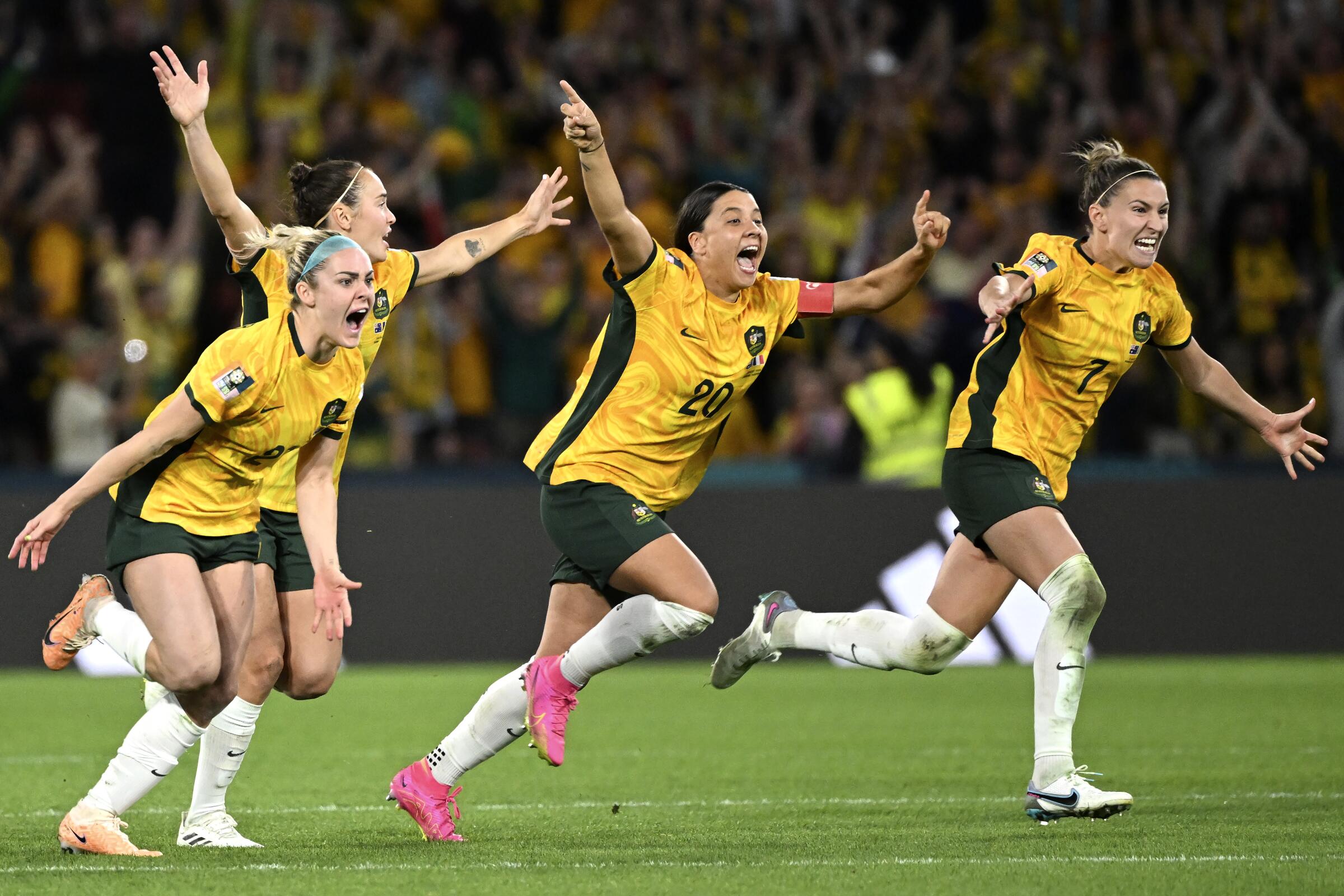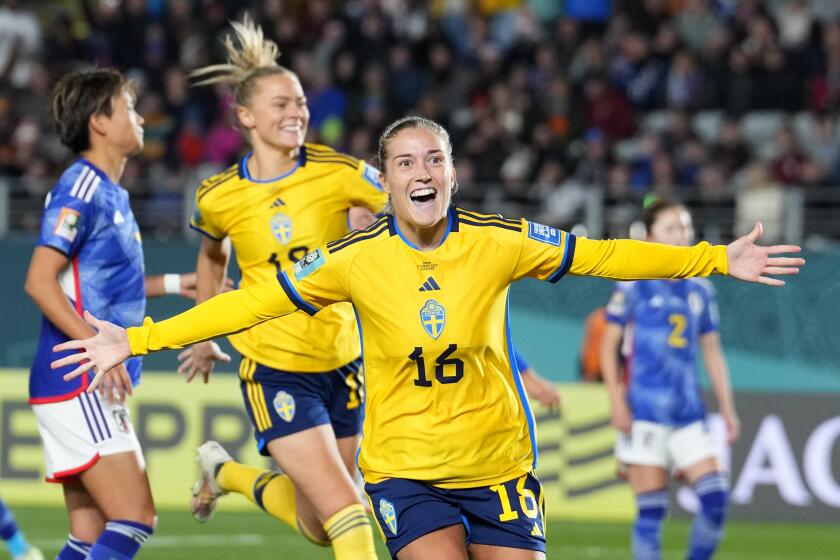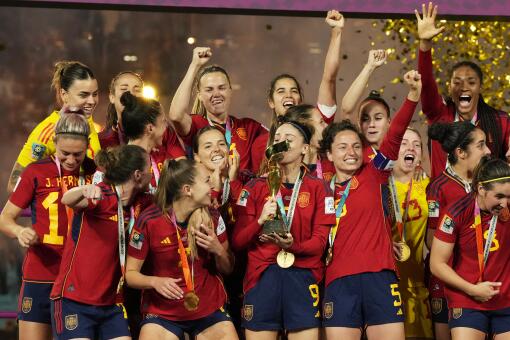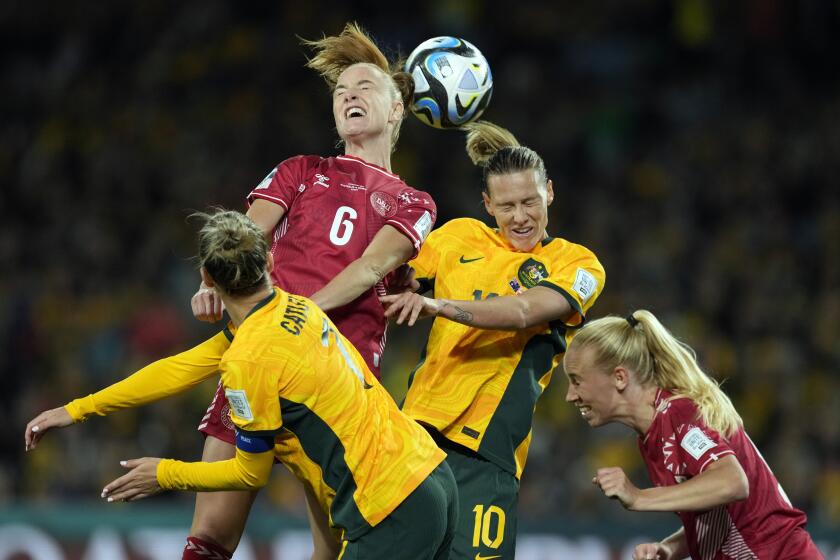Kevin Baxter writes about soccer and hockey for the Los Angeles Times. He has covered seven World Cups, five Olympic Games, six World Series and a Super Bowl and has contributed to three Pulitzer Prize-winning series at The Times and Miami Herald. An essay he wrote in fifth grade was voted best in the class. He has a cool dog.
- Share via
1
Shortly before NWSL Commissioner Jessica Berman arrived at the Women’s World Cup in Australia, the U.S. was eliminated from the tournament. The metaphor was obvious: the NWSL, once home to the majority of the top players on the planet, and the U.S. national team, a four-time World Cup champion, are now both struggling to keep up.
In 2015, nearly 1 in 10 World Cup players came from the league. Four years ago, the percentage was even higher. This summer, however, England’s Women’s Super League surged past the NWSL, placing 94 of its women on World Cup rosters, accounting for nearly 13% of the players in the tournament. Seventy of those players were on teams that reached the round of 16, according to Sportico, and 40 made the semifinals, half of them playing for England.
Spain’s Liga F sent the second-most players to the tournament with 72, followed by the NWSL, which was a distant third despite placing a league-record 61 players on the 32 teams that started the tournament. With the U.S. team’s early exit in the round of 16, only three NWSL players reached the semifinals.
More former NWSL players advanced.
Sweden held off Japan in a women’s World Cup quarterfinal, cementing this as a tournament of upsets. Soccer will soon crown a first-time Cup winner.
Australian captain Sam Kerr, the NWSL’s all-time leading scorer, now plays in England for Chelsea. England’s Rachel Daly, MVP of the 2020 NWSL Challenge Cup, plays for Aston Villa, while former Houston Dash teammates Lydia Williams and Clare Polkinghorne, both on the Australian team, play for clubs in England and Sweden, respectively. Mackenzie Arnold, who spent a season as a backup goalkeeper with the NWSL’s Chicago Red Stars, now starts in England for West Ham United, while Australian teammates Stephanie Elise-Catley, who played for three NWSL clubs, is now in England with Arsenal; former NWSL champion Alanna Kennedy plays for Manchester City; and Ellie Carpenter, once the youngest player in NWSL history, is with Lyon in France.
But if that’s the NWSL’s loss, it’s clearly global soccer’s gain. Especially since the rest of the world is following the NWSL blueprint, increasing investment in top-flight leagues and improving the level of play everywhere. This summer’s World Cup, the largest and most competitive in history, is proof of that.
Take the WSL as an example. After the last World Cup, Barclay’s bank paid $12.7 million to sponsor the league, a figure it doubled two years later with investments aimed at offering girls equal access to soccer in schools by 2024. Two years ago, the WSL also signed a three-year broadcast deal with Sky Sports and the BBC, which led to record revenues and an attendance jump of 173%.
The national team rewarded that support last summer by winning its first European championship, and then followed that up this summer with an unbeaten run to the World Cup semifinals.
A little more than a generation ago, girls were largely banned from playing organized soccer in England. Now major corporations there are lining up to sponsor them.
The women’s game may have made an even quicker assent in Spain. Although the country has had a top-flight women’s league since 1988, it wasn’t granted official professional status by the Spanish federation until 2020. Since then, it has grown to 16 teams, signed a five-year broadcast agreement with DAZA and banked about $80 million in media and commercial partnerships, according to league officials.
Barcelona Femení and the Spanish national team have been the chief beneficiaries, with Barcelona reaching the Champions League final in each of the last three seasons while Spain is in the World Cup semifinals just eight years after going winless in its tournament debut.
“We are very proud with the achievements of our women’s team, but this isn’t something that could happen overnight,” said Barcelona President Joan Laporta, whose club placed nine players on the World Cup roster, among them Alexis Putellas, the two-time reigning world player of the year, and Aitana Bonmatí, who has scored three times in the tournament.
“There has been an extraordinary and consistent work for years from a great group of professionals within the organization,” Laporta said. “You cannot improvise players like Alexia Putellas or Aitana Bonmatí and need to create the right structures and environment to ensure their talent could bloom, and then attract international talent like [England internationals] Keira Walsh or Lucy Bronze. This is what we have been working on as an institution for years, as a strategy that goes from soccer grassroots to the top professional level.”
Spain’s team is the most homogenous of the semifinalists with only one woman — former Barcelona forward Jennifer Hermoso, now with Mexico’s Pachuca — playing for a club outside Spain.
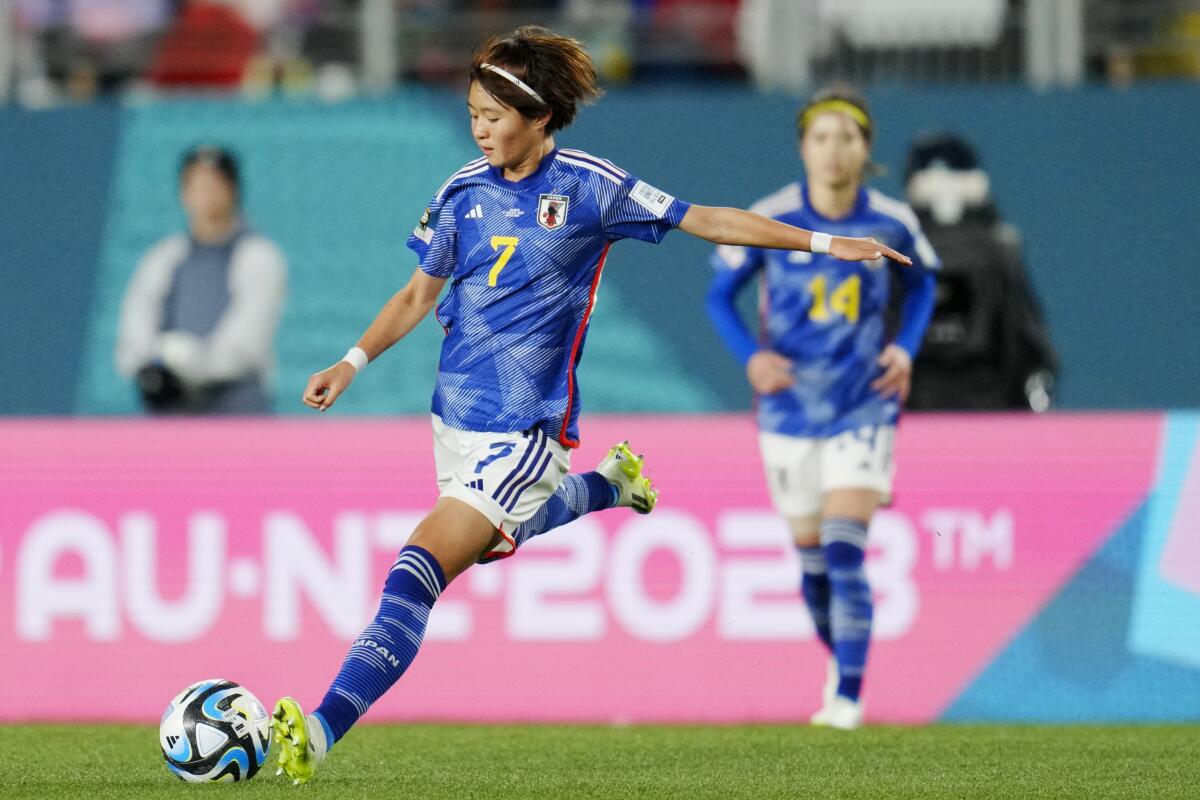
Japan’s Hinata Miyazawa passes the ball during a Women’s World Cup quarterfinal game against Sweden on Aug. 11.
(Abbie Parr / Associated Press)
Other countries have begun making more modest investments in the women’s game, but have also been rewarded with huge benefits. In Japan, the focus has been on building a solid foundation at the grassroots level, where more than 30,000 girls have registered to play. The country’s 12-team domestic WE League — the initials stand for Women’s Empowerment — was launched in June 2020, three months into the COVID-19 pandemic, and although it has struggled to catch on, 14 of the 23 players on the Japanese team that made the World Cup quarterfinals came off WE rosters, among them Hinata Miyazawa, the tournament’s leading scorer with five goals, and Mina Tanaka, who is tied for the tournament lead with three assists.
But perhaps the clearest sign that the investment in women’s leagues is paying dividends isn’t in the number of players those domestic leagues produce for their country’s national teams, but rather how many they produce for other national teams, rivaling a decades-old trend in the men’s game. In last fall’s men’s World Cup, for example, the English Premier League supplied players for 26 of the 32 World Cup teams, one more than Spain’s La Liga.
The 12-team WSL has had a similar influence this summer, sending players to half the 32 World Cup teams, including three of the four semifinalists. The NWSL also had players on 16 World Cup teams, including two of the final four. But if the NWSL’s numbers have declined, the league’s influence has not. After all, it was the success of both the league and the U.S. national team that made investors in Europe and elsewhere realize that women’s soccer was worth supporting in the first place.
So what if the NWSL commissioner arrived late and the U.S. left the party early this year? Without them, there might not have been much worth celebrating.
Complete schedules for the 2023 Women’s World Cup knockout rounds, along with match previews and every score from group play.
⚽ You have read the latest installment of On Soccer with Kevin Baxter. The weekly column takes you behind the scenes and shines a spotlight on unique stories. Listen to Baxter on this week’s episode of the Corner of the Galaxy podcast.
